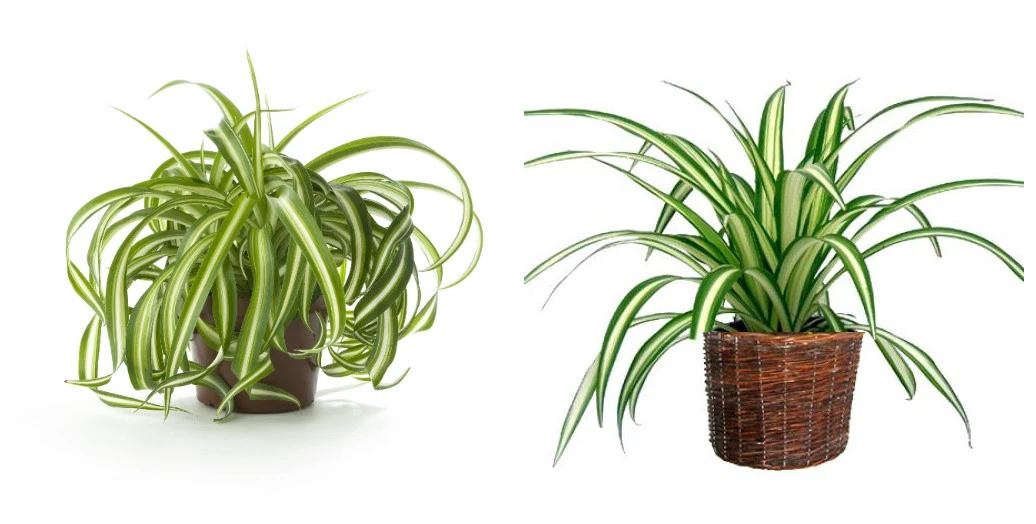Chlorophytum is a perennial herbaceous plant with elongated green, greenish-white leaves 10 to 60 cm long, gathered in a dense rosette, and drooping peduncles on which white small flowers bloom, which after flowering become airy whiskers. The flower belongs to the lily family.
Today there are up to 250 species of Chlorophytum, which grow in the humid rivers of the tropics and subtropics of America and South Africa. This plant differs from other houseplants in that it quickly adapts to any home environment and is very easy to care for. This plant can be recommended for novice gardeners, because it is very resistant and completely insensitive to sudden changes in temperature, light and humidity.
The most common Chlorophytum crested (Chlorophytum comosum). It produces a mustache on which babies (small plants) that can take root appear. Ornamental species Chlorophytum comosum vittatum – with a few white stripes in the middle of the leaves, Chlorophytum comosum variegatum with white stripes on the edges of the leaves, Chlorophytum curly (Chlorophytum comosum bonnie).
Due to the thick air outlets, chlorophytum is used as an ampel plant.

Chlorophytum is an air vacuum cleaner plant
Features of chlorophytum, useful for humans:
- Cleans the air in the room from formaldehyde, phenol, vapors of acetone, nitrogen, ammonia, which are released from furniture and laminate.
- During the day the plant absorbs up to 80% of harmful microorganisms, helps to destroy mold, releases a substance that is harmful to pests.
- One adult plant can purify air up to 6 square meters, and several such plants can replace an expensive air purifier.
- Chlorophytum is also a humidifier. And when adding coal to the soil, moisture increases several times.
- Ability to quickly absorb and remove harmful substances, such as carbon monoxide, which are released during the operation of the gas stove. Therefore, this plant is recommended to put in the kitchen.
- Chlorophytum is good for people with allergies and respiratory diseases, people who live near roads and in industrial areas, because it cleans the air very well.
Thanks to the many hybrid species, we can choose the plant we like best. With proper care, this plant will delight the eye with its abundant rosettes and colorful leaves.
How to care for Chlorophytum
Chlorophytum is very easy to care for.
This plant adapts to the indoor climate and feels good in the shade, in sunny, semi-sunny places.
Air temperature
Chlorophytum is resistant to sudden changes in temperature. In the period spring-summer-autumn air temperature is moderate, about 18-25 degrees C. In winter, enough room temperature, but not below 8 degrees. The plant grows best at temperatures from 10 to 18 degrees.
Brightness of light for Chlorophytum
Chlorophytum feels good and thrives in the sun, shade and semi-sunny places. In the sun, the plant can be in the open ground, because the sun is almost always accompanied by a light wind, which softens direct sunlight. On the windowsill on the south side of apartments or houses, this plant will not feel very well (hot): the leaves turn pale, the tips dry out, the lower leaves wither.

Chlorophytum grows well in shaded areas.
How to water chlorophytum?
Any water is suitable: from the tap, soft, rainy, river. From spring to autumn, during the period of active growth, watered every 3-4 days, in winter, at rest – enough 1 time in 7 days. A feature of the root system of Chlorophytum is the fleshy roots, which accumulate water to humidify the air. Excessive watering can cause root rot, so allow the top layer of soil to dry between waterings.
Air humidity
From time to time in the summer and during the heating season it is useful to spray the plant. Enough once a day before lunch.
How to feed
You need to start fertilizing the plant in the period from spring to autumn once every 14 days. Use fertilizers for ornamental and deciduous plants.
Nitrogen fertilizer is best. Nitrogen stimulates leaf growth.
Transplantation and reproduction
If necessary – in the spring. There are no difficulties in the reproduction of Chlorophytum. Propagated vegetatively, mustache, dividing the bush when transplanting.
Pests
In fact, Chlorophytum has few enemies – it’s just an aphid that threatens weakened plants.

